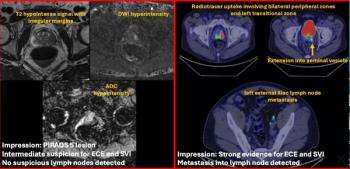
Some turn to software-only PACS, but others doubt any advantage
A trend toward software-only PACS has emerged in the past few months. Software-only PACS permit healthcare institutions to leverage their internal investments in desktop PCs and ultimately install PACS more economically. In September, for instance,
A trend toward software-only PACS has emerged in the past few months. Software-only PACS permit healthcare institutions to leverage their internal investments in desktop PCs and ultimately install PACS more economically.
In September, for instance, Texas Health Resources (THR), the largest integrated nonprofit healthcare organization in Texas, selected Fuji Medical Systems' Synapse software-only PACS as its enterprise-wide source for image and information management. This approach allowed THR to install Synapse software without requiring supplementary hardware components, enjoying the benefits of PACS while minimizing capital expenditures.
"I think this is the way PACS will go in the future, because hardware becomes more of a commodity," said Peter McLennan, national marketing manager, Imaging and Information Networks, Fuji Medical Systems. "The true value is in the software."
This variation of the complex PACS world started to become popular when customers began wondering whether the cost of PACS could be reduced if they purchased their own hardware. Fuji now has 30 software-only PACS clients, according to McLennan.
Other big vendors aren't so sure there's always an advantage to a software-only approach.
"What our customers have learned in the last year is that you don't save much money if you buy hardware yourself," said Dean Kaufman, director of Strategic Marketing for Agfa.
"Vendors can get hardware less expensive than any one site can," he said. "Companies buy in volume, with negotiated discounts. Many hardware vendors - monitor, display card, and server vendors - don't even sell to end users. They only do B2B."
Sometimes, buying groups can help.
"Most big or even medium size institutions are members of buying groups," Kaufman said. "They actually get better prices than what we get. And they can pick the equipment they want."
Hardware costs aside, one factor that does limit software-only candidacy is the need for an information technology department.
"It's really not so much the size of the institution, but the internal talent that it has," McLennan said. "If it doesn't have an IT department, we wouldn't recommend a software-only approach. Healthcare institutions are becoming much more savvy about IT."
Smaller hospitals without large IT infrastructures wouldn't be helped by software-only PACS, said Henri "Rik" Primo, director of new business development for Siemens Medical Systems.
"Small hospitals ask vendors for an integrated turnkey system," he said. "They don't want to be bothered because they don't have the support staff."
Newsletter
Stay at the forefront of radiology with the Diagnostic Imaging newsletter, delivering the latest news, clinical insights, and imaging advancements for today’s radiologists.




























